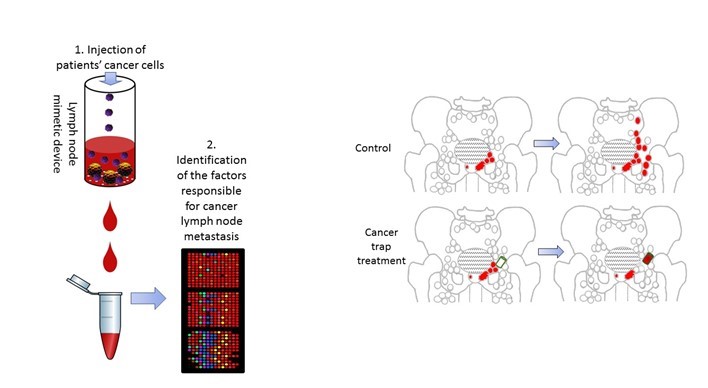Prostate Cancer
Artificial Lymph Node: A Trap to Study and Fight Prostate Cancer



Posted September 18, 2019
Dr. Liping Tang, Ph.D., University of Texas at Arlington

The spreading of prostate cancer to the lymph nodes is the hallmark of cancer metastasis, which has a significant negative effect on patient survival. Unfortunately, the mechanism(s) governing prostate cancer lymph node metastasis is not completely understood, and there is no specific treatment for reducing such metastasis. Since lymph nodes are small organs spread out all over the body, investigating their mechanisms is very difficult. With the support from a FY13 Idea Development Award, Dr. Liping Tang and his interdisciplinary team of investigators developed a lymph node device that can be used for studying lymph node and cancer interactions.
Dr. Tang and his colleagues first discovered that highly metastatic prostate cancer, but not low metastatic prostate cancer, would cause lymph nodes to swell. By comparing the cellular and protein components between swollen and naïve lymph nodes, the research team found that the invasion of highly metastatic prostate cancer cells, but not low-metastatic cancer cells, would activate lymph node T cells to produce several key chemokines that play a role in cancer metastasis. Based on these results, the investigative team built a T cells-seeded lymph node device in order to more closely examine cancer and T cell interactions. Results show that the lymph node device can trigger differential responses to both highly metastatic and low-metastatic prostate cancer. For example, placing the lymph node device near the primary tumor in animals was shown to reduce lymph node metastasis by actively capturing circulating prostate cancer cells.
Dr. Tang is currently engineering a new lymph node device for both metastatic cancer diagnosis in vitro and prostate cancer lymph node metastasis treatment in vivo. For in vitro diagnosis, uncharacterized prostate cancer cells can be placed in the 3D lymph node device. By analyzing the “lymph fluid” from the device using protein array technology, he can determine whether unknown cancer cells have metastatic potential. In addition, based on the identified biomolecules, a specific and personalized treatment for reducing lymph node metastasis may be developed. For in vivo treatment, a 3D implantable lymph node device will be made for easy implantation nearby the primary tumor. Such an implant can serve as a “cancer trap” for capturing metastatic prostate cancer cells and reducing lymph node metastasis.

Figure: Schematic illustration of cancer trap for intercepting prostate cancer cells from lymph node metastasis.
Note: This work was carried out by an interdisciplinary team of investigators. Majority of the research work was carried out by two Bioengineering PhD students -YiHui Huang and Amirhossein Hakamivala under the mentorship of Dr. Liping Tang at the University of Texas at Arlington. Dr. Jer-Tsong Hsieh (University of Texas Southwestern Medical Center at Dallas) provided critical guidance and technical support on the development and translation of this new technology.
References:
https://www.uta.edu/news/releases/2017/01/Cancer%20release%20summary.php
https://www.youtube.com/watch?v=MRWY3IWvBQ0
Link:
Public and Technical Abstracts: Tissue-Engineered Constructs for Investigating the Effect of Lymph Node Microenvironment on Prostate Cancer Metastasis
Last updated Thursday, December 5, 2024














